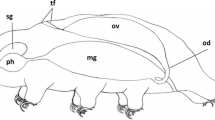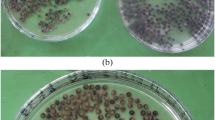Summary
The development of embryo-sac and embryo has been described inSpermacoce hispida andGuettarda speciosa.
The haploid numbers,Spermacoce (n = 28) andGuettarda (n = 22), previously reported, are confirmed. Meiosis is described in some detail.
The development of the strophiole has been traced and it is considered to have little phylogenetic importance.
The suggestion previously made that 11 was the basic number of the family is confirmed by data gathered in this paper.
The evolution of the chromosome numbers in this family is discussed in the light of data known in connection with nucellar evolution. A correlation is established between the two and a few tentative schemes of nucellar and chromosomal evolution suggested.
Similar content being viewed by others
Literature Cited
Fagerlind, F. “Embryologische, Zytologische und Bestäubungs experiment elle Studien in Der Familie Rubiaceæ nebst Bemarkungen, über linige polyploiditäts probleme,”Acta Horti Bergianni, 1937,11, 9, 195.
Howk, W. G. “Endosperm and perisperm of coffee with notes on the morphology of ovule and seed development,”Amer. Jour. Bot., 1938,25, 56.
Lawrence, W. J. C. “The secondary association of chromosomes,”Cytologia, 1931,2, 352.
Lloyd, F. E. “The comparative embryology of Rubiaceæ,”Mem. Torr. Bot. Club, 1902,8, 1.
Maheshwari, P. “A critical review of the types of embryo-sacs in Angiosperms,”New Phyt., 1937,36, 359.
Nandi, H. K. “The Chromosome Morphology, Secondary Association and Origin of Cultivated Rice,”Jour. Gen., 1936,33, 315.
Raghavan, T. S. “Morphological and cytological studies in Capparidaceæ. II. Floral morphology and Cytology ofGynandropsis pentaphylla DC.,”Ann. Bot., 1938, New Ser.,2, 75.
- and Rangaswamy, K. “Studies in Rubiaceæ. I. Development of female gametophyte and embryo formation inDentella repens Forst. andOldenlandia alata Koch and some Cyto-taxonomical considerations,”Jour. Ind. Bot. Soc., 1941;20, No. 5.
- and Srinivasan, A. R. “Cytogenetical studies inNicotiana. I,”ibid., 1941a,20, No. 5.
- “Cytogenetical studies inNicotiana. II. Morphological features ofNicotiana glutinosa and the hybrid betweenN. glutinosa andN. tabacum,” Proc. Ind. Acad. Sci., (B), 1941b,14, No. 1.
Raghavan, T. S., and “Contribution to the Cytology ofTridax procumbens Linn.,” Venkatasubban, K. R. —, 1941,12, 85.
Author information
Authors and Affiliations
Additional information
An erratum to this article is available at http://dx.doi.org/10.1007/BF03049132.
Rights and permissions
About this article
Cite this article
Raghavan, T.S., Srinivasan, A.R. Studies in rubiaceÆ. Proc. Indian Acad. Sci. 14, 412–426 (1941). https://doi.org/10.1007/BF03051152
Received:
Issue Date:
DOI: https://doi.org/10.1007/BF03051152




